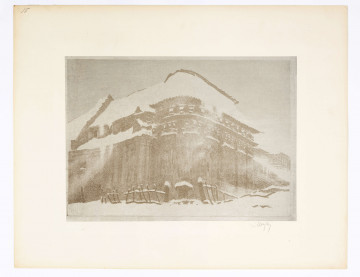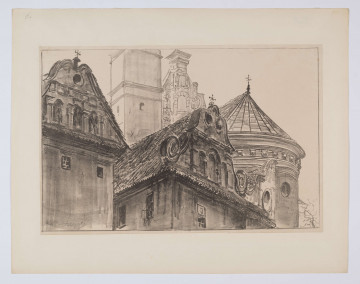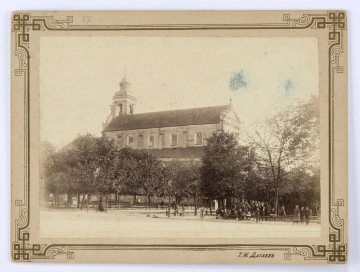
Church of Saint Adalbert in Lublin
1918 — 1919
National Museum in Lublin
Part of the collection: Lubliniana. Painting views of Lublin and the Lublin Region (17th–early 20th c.)
The portfolio Lublin belongs to the mature graphic works of Leon Wyczółkowski, who devoted over thirty years of his artistic activity to graphic art, abandoning oil painting in its favour. He became interested in the graphic medium around 1900. Already as a mature, recognised artist he began to analyse the technical possibilities of etching, aquatint, algraphy, fluorophores and, above all, lithography. Thanks to the similarity of the effects of a lithographic print to drawing and painting and the possibilities for experimentation that best suited Wyczółkowski's preferences and temperament, lithography became the artist's favourite technique. He published cycles of graphic works in low-cost portfolios devoted to the landscape and architecture of Polish cities. In his panoramic city views, shots of historic buildings and meticulously reconstructed architectural details, he combined documentary skills with an extraordinary passion for individual feeling of architecture.
Teka Lublin is one of the most beautiful graphic portraits of the city, which the artist supplemented with three boards not related to architecture. These include two versions of Sosenka [The Pine] and Stara lipa w Piotrawinie [The Old Lime in Piotrawina]. Wyczółkowski prepared the drawing sketches during his stay in Lublin in 1918. Composed of seventeen auto-lithographic boards, the portfolio was published a year later in Kraków in twenty copies. After printing the edition assumed by the artist the lithographic stones were destroyed, which in Wyczółkowski's case was a frequent practice and gave his prints a unique character. In the last sheet of the portfolio, as in the case of Fryz na gmachu Seminarium [The Frieze on the Edifice of the Seminary] and Bernardyni [The Bernardines], the artist concentrated on a small fragment of architecture. A fragment of the façade with a surprisingly framed lower part of the column portico and stairs leading to the cathedral can be treated as an equivalent of the whole. The reduction of form, resulting from the narrowing of the frame, betrays the influence of Japanese woodcuts and the love of architectural detail, characteristic of the artist's mature works. The effect of nocturnal light is enhanced by the greyish colours and soft contours blurring in the darkness.
Anna Hałata
Author / creator
Dimensions
cały obiekt: height: 39,9 cm, width: 33,5 cm
Object type
graphics
Material
paper
Creation time / dating
Creation / finding place
Owner
The National Museum in Lublin
Identification number
Location / status

1918 — 1919
National Museum in Lublin

1918 — 1919
National Museum in Lublin

1890 — 1910
National Museum in Lublin
DISCOVER this TOPIC
Castle Museum in Łańcut
DISCOVER this PATH
Educational path